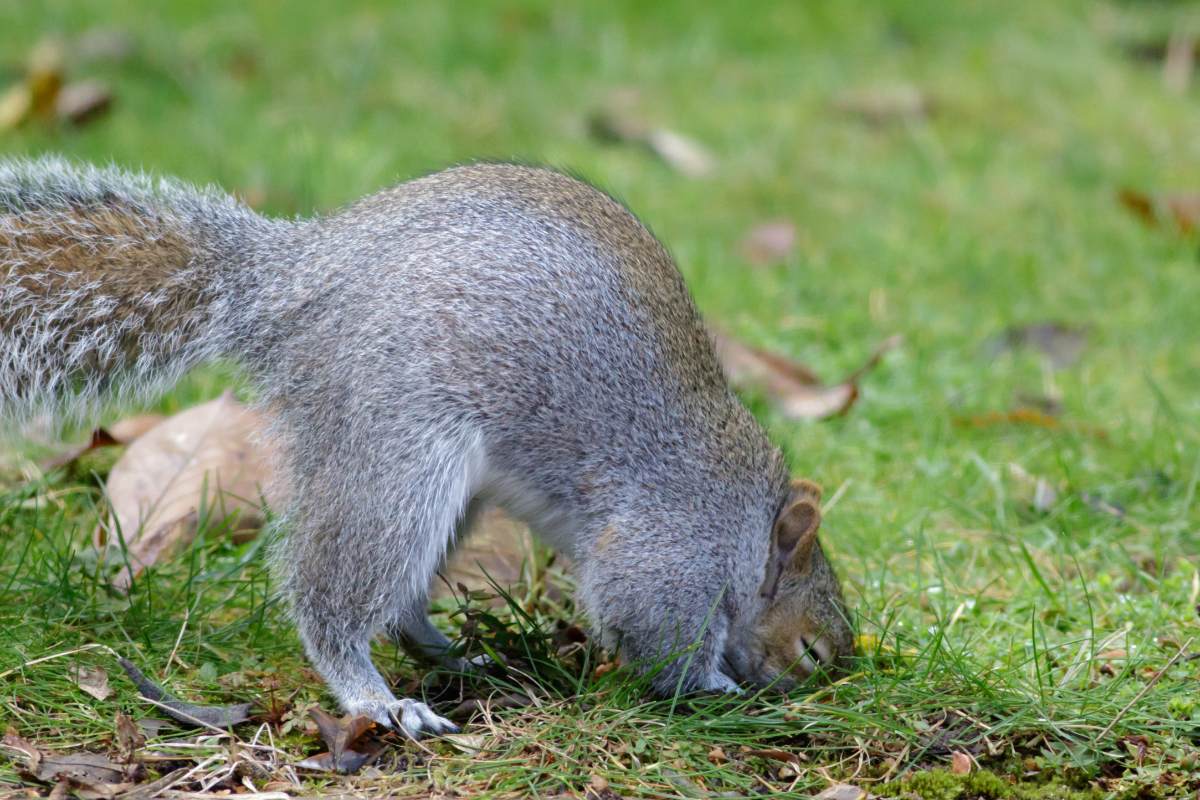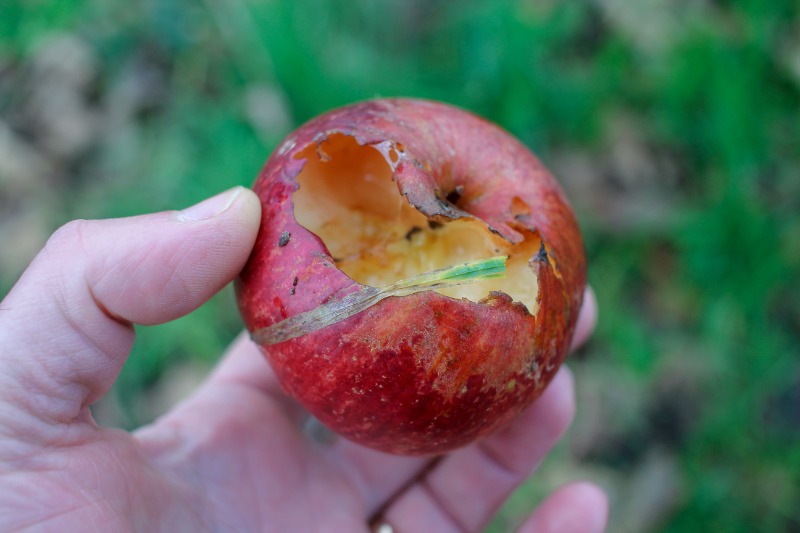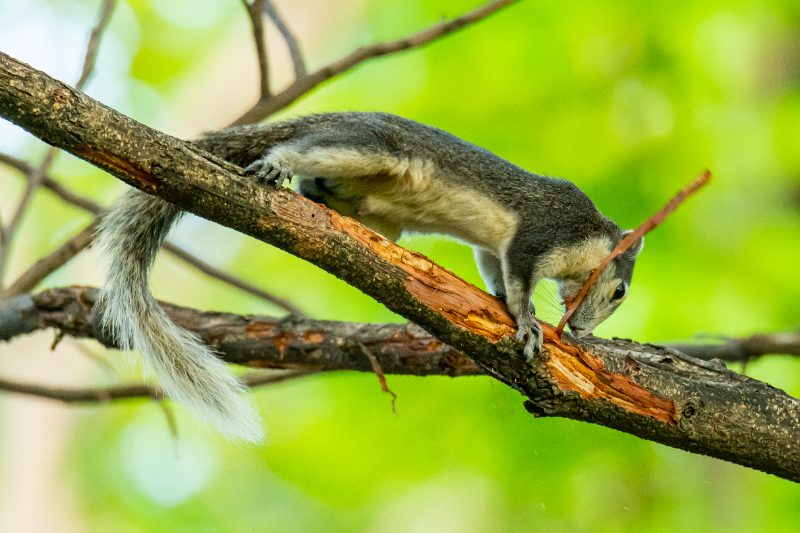
Something is digging up your yard, but you can’t figure out what? Look for these squirrel giveaways: small, cone-shaped holes in your lawn, ransacked bird feeders, and damaged flower bulbs.
Need more proof? We’ll walk you through the top 10 signs squirrels are digging in your yard so you can confirm the culprit without a doubt and start protecting your property from further damage.
- 1. You Spot Squirrels in the Yard
- 2. Small, Cone-Shaped Holes
- 3. Mounds of Freshly Dug Dirt
- 4. Disturbed Mulch and Garden Beds
- 5. Damage to Newly Planted Bulbs
- 6. Damage Around Bird Feeders (and Missing Food)
- 7. Food Scraps and Hidden Stashes
- 8. Yard Damage in Fall and Spring
- 9. Stripped Bark on Tree Trunks and Branches
- 10. Free Tree Pruning
1. You Spot Squirrels in the Yard
Squirrels are hard to miss. Unlike “nocturnal pests like rats, squirrels are bold and active during the day, so you’ll often catch them in the act,” says Sabrina Kong, DVM, a practicing veterinarian at Jules Veterinary Center in Tracy, California.
You’ll usually have either tree squirrels or ground squirrels in your yard:
- Tree squirrels sport long, bushy tails and dart up trees and structures when startled.
- Ground squirrels have mottled gray-brown fur, with stripes or spots, and noticeably shorter tails. When threatened, they hide in underground burrows.
2. Small, Cone-Shaped Holes
Why are squirrels digging in your yard? They’re searching for and burying food. Squirrels make small, cone-shaped holes — about 2-3 inches wide and deep — to stash nuts and acorns, turning your lawn into their private pantry.
And we’re not talking about just 1 or 2 holes. Since they’re storing food for an entire winter, you’ll see clusters of these tiny divots all over your yard.
“My lawn often looks like a miniature bombing range,” says Kong. In California, where she lives, yard damage is often caused by the eastern fox squirrel, a tree squirrel species.
These small holes are more specific to tree squirrels, which live in tree hollows or dreys (nests of twigs and leaves built high in the tree) and store food in the ground around their nest.
Pro Tip: One way to keep squirrels from destroying your yard is to install motion-activated sprinklers.
3. Mounds of Freshly Dug Dirt
If ground squirrels live in your yard, you might find out by tripping on one of their mounds.
Ground squirrels live in underground tunnels that run 2 to 4.5 feet deep and 5 to 30 feet long, serving as both nests and food storage areas. Their burrow entrances are 4-6 inches wide — big enough to fit your fist — often with mounds of freshly dug soil nearby.
Unlike gophers and moles, who pile up neat conical mounds over their tunnel openings, squirrel mounds are messy and don’t cover their entrance.
Besides the obvious holes and mounds, other warning signs can also indicate their presence:
- Dead patches of grass: Tunneling damages roots and creates gaps in the soil that let water drain away instead of reaching the grass. This leaves dry, brown spots across your lawn.
- Uneven, bumpy ground: Your mower dips and bounces instead of gliding smoothly — a sure sign the soil beneath has been disturbed.
See Related:
4. Disturbed Mulch and Garden Beds
Another sign that squirrels are visiting your yard is disturbed garden beds, where these furry pests like to dig.
“The soft, moist soil makes for easy digging,” says Kong. Throw in the seeds or bulbs you just planted, plus tender seedlings poking through, and you’ve got an all-you-can-eat buffet squirrels can’t resist.
What you’ll typically see is:
- Mulch piled or heaped to the side of small depressions and bare, disturbed soil in the middle
- Uneven mulch depth across the bed, with some spots nearly bare and others piled high
- Wood chips or bark are kicked outside the bed boundaries
How can you keep squirrels from digging in your landscaping beds? Try using pine cones as mulch or adding thorny branches over your garden beds. Spreading chilli pepper flakes is also recommended, but it needs frequent reapplication.
See Related: How to Keep Mulch in Place
5. Damage to Newly Planted Bulbs
Squirrels will dig out your flower bulbs as soon as you plant them. They’ll eat their favorites — like tulips and crocuses — leaving only empty holes. Bulbs they don’t like, you’ll find scattered around the yard with bite marks.
The good news? Some bulbs are toxic to squirrels. They won’t touch them, and you can use these plants that naturally deter squirrels from digging to protect your flower beds. The most popular are:
- Daffodils
- Snowdrops
- Grape hyacinths
- Alliums
Pro Tip: Another method to stop squirrels from digging in your yard is to lay hardware cloth over the planted area.
See Related: Planting Bulbs in Fall: What to Plant, When, and How
6. Damage Around Bird Feeders (and Missing Food)
A broken or chewed-up bird feeder is a clear sign that squirrels have moved into your neighborhood and are raiding your yard. And so are seeds scattered on the ground.
Squirrels see bird feeders as free meals and will stop at nothing to plunder them. They’ll pry off caps to reach the seeds inside, chew through plastic corners, or leap onto feeders from nearby trees, roofs, and fences — often sending the whole thing crashing to the ground.
Pro Tip: Bird feeders are squirrel magnets. If you’re wondering how to get rid of the squirrels in your yard, start with the feeder — either remove it or upgrade to a squirrel-proof model that blocks access to seeds.
7. Food Scraps and Hidden Stashes

Anyone who’s dealt with squirrels knows they are messy eaters. If they’re feeding in your yard, you’ll find food scraps, often under and near trees — half-eaten fruits, acorn shells, and pine cone scales and cores littered across the ground.
They’re also creatures of habit. Once they find a cozy place to munch, they’ll keep coming back, so it’s common to see a buildup of debris in particular areas rather than evenly spread across your whole yard.
What you’re more likely to find randomly across the yard are partially buried nuts and acorns, since squirrels cache food all over the place.
8. Yard Damage in Fall and Spring
While squirrels are active year-round, their digging is most problematic in the fall and spring. Kong says that between these “two squirrel seasons,” fall is the worst.
“The fall is by far the most destructive, as they’re frantically burying nuts for the winter,” says Kong. Where they dig, they’ll usually uproot plants, leaving behind dead grass and small bare patches.
According to Kong, “Spring is a close second, as they’re digging up all that buried treasure and also making new burrows for their young.” During spring, “the soft, moist soil makes for easy digging,” and new lawns and gardens take the biggest hit. Why? To a squirrel, freshly planted areas look like soft digging with a chance of buried snacks.
Bottom line: Expect to repair and overseed your lawn more than once a year when squirrels are around.
See Related: How Often Should You Overseed Your Lawn?
9. Stripped Bark on Tree Trunks and Branches

Tree bark isn’t squirrels’ first choice as a snack, but they’ll settle for it throughout the spring and early summer when pickings are slim. They’ll remove the outer bark of trees and eat the inner bark, which is rich in nutrients. According to the Ohio State University, most bark stripping happens between April and July.
Unlike ground-dwelling pests, like gophers, deer, and rabbits, squirrels can climb. You may see stripped bark anywhere on a tree, from the base to the upper trunk and branches. The trees that take the biggest hit? American beech, honeylocust, and maples.
Trees use their inner bark to carry water and nutrients. Debarking damages this system, and girdling (chewing a ring of bark around the tree) stops the flow completely, eventually killing the tree. The same thing can happen with shrubs.
Pro Tip: Before you go trapping the culprits, check local laws. In some states, you’ll need a permit to trap squirrels. In others, relocating the squirrels is illegal.
10. Free Tree Pruning
Twig tips with green leaves scattered on the ground often mean squirrels are building nests. Squirrels will also lop the twig tips to sharpen their teeth or get easier access to the nuts and seeds they carry.
Either way, it’s not a natural occurrence — it’s another sign you might have squirrels in your yard.
Make Your Yard Squirrel-Unfriendly
Think you have squirrels digging on your property? Take precautions. Hire a LawnStarter pro to trim the trees near your house and keep squirrels out of your attic.
Our pros can also help with lawn mowing, leaf removal, and bush trimming to keep your yard neat, clean, and less attractive to squirrels and other garden pests.
Sources:
- “Bark Stripping.” Internet Center for Wildlife Damage Management.
- Sabrina Kong, DVM, Jules Veterinary Center in Tracy, California, and staff veterinarian at WeLoveDoodles. Personal interview.
- “Ground Squirrel.” By Niamh Quinn, human-wildlife interactions advisor, Roger A. Baldwin, cooperative Extension specialist in human-wildlife conflict resolution, and Monica Dimson, digital media specialist. University of California.
- “Squirrels Debarking Trees.” By Joe Boggs, assistant professor. The Ohio State University.
Main Image: Squirrel digging in the grassy ground. Image Credit: shaftinaction / Adobe Stock